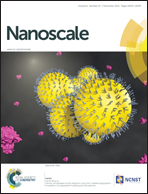Simple fabrication of a three-dimensional porous polymer film as a diffuser for organic light emitting diodes
Abstract
We have investigated a simple and cost-effective fabrication method for a porous polymer film employing the spin-coating process during continuous supply of water droplets by an ultrasonic humidifier. The resulting porous polymer film showed ∼40% optical haze, and this film could be used as a diffuser film for strong microcavity OLEDs. Specifically, we focused on controlling the surface morphology to give a three-dimensional (3D) multi-stacked nanocave structure because we had already learnt that two-dimensional nanoporous structures showed serious loss of luminance in the forward direction. As a result, we found that a 3D-ordered multi-stacked nanocave structure with a relatively small diameter and a distribution range of 300–500 nm can be obtained by precise control of the elastic bouncing behaviour of the supplied water droplets. Using this approach, we found that the 3D nanoporous polymer film can effectively reduce the viewing angle dependency of strong microcavity OLEDs without any considerable decrease in the total intensity of the out-coupled light.


 Please wait while we load your content...
Please wait while we load your content...